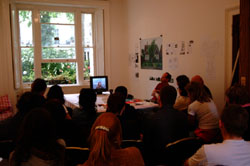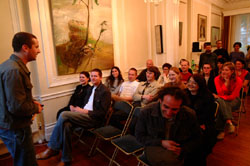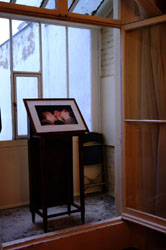B+B at Home with the P.A.R.A.S.I.T.E Museum of Contemporary Art
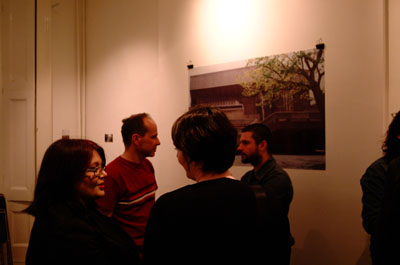
A Perfect Place
25 May 2003
Tadej Pogacar of the P.A.RR.A.S.I.T.E. Museum of Contemporary Art (PMCA) was in redsidence at B+B at Home in May 2003. A Perfect Place presented Tadej's ongoing research into Constructed Cities which he continued during his residency by visiting Milton Keynes, Letchworth Garden City and the South Bank in London. Tadej also presented CODE:RED, an ongoing PMCA project.
'The Department of Anthropology and the Department of Every Day Life of the P.A.R.A.S.I.T.E Museum of Contemporary Art (PMCA) proudly present the project "A Perfect Place"."A Perfect Place" brings together the snap shots of Tadej Pogacar"s roaming through the city during his three week residency with B+B at Home. The act of walking, as Michel de Certeau states, is a "pedestrian speech act" connected to every day experience and personal voices in the city. ' Tdaej Pogacar.
A Perfect Place celebrated the 10th Anniversary of the PMCA. For this event, Tadej presented the FIRST ANNUAL B+B BENEFIT AUCTION, with special guest auctioneer Alasdair Hopwood. This was a chance to bid for a piece of the P.A.R.A.S.I.T.E entitled "AN IDEAL COMMUNITY".
This residency was made possible thanks to the support of Visiting Arts.
A Perfect Place - England Utopia by Tadej Pogacar
A Perfect Place is a period of research into three different models of architecture, city planning and urbanism that appeared in England in the last century. It is a subjective insight in different utopian models of ideal cities and related ideologies.
In 1902 Ebenezer Howard published his "Garden City of To-morrow" with the famous diagram of the three magnets that explained his ideas and vision. Letchworth is the very first example of new model for the city: a Garden City. It was a result of utopian aim and vision to build an alternative community. The Garden City was a "building bloc in the progressive reconstruction of society as a whole". The garden city movement was against state ruled society and capitalistic production; they rather supported a network of communities and cooperation with the desire to replace mass production.
A new esthetic programme of "brutalism" (South Bank, London) is a utopian model and vision of modernism. The concrete city is a paradigm of architecture as subjective artistic expresion. The genious visions that come before the needs of the human beings who have to use them or as Le Corbosier puts it: "A house is a machine for living."
Milton Keynes is the largest town of 32 new built towns in Britain since
1946. It is an English version of an American freeway-linked city (Los Angeles)
with a clear message (as you can read in the local commercial announcement):
"no more neighbourhoods, just a city with a wide range of oportunities...
each citizen can select his ideal life style.."
Milton Keynes is a grid city with devided sectors of working and living. It is a drive-in city and pedestrians have no priority. The city centre is turned into a controlled shopping mall, mirroring an aesthetic of idea consumer society (first american stile shopping mall in Europe) and social life is reduced to consumption.
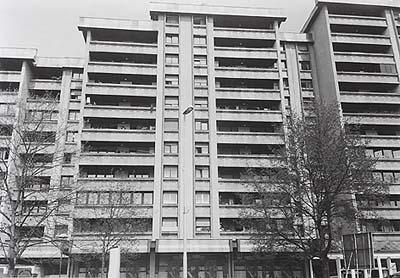
photo: Titovo Velenje
